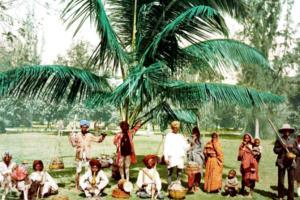It's curiosity that eventually compelled John Zubrzycki to invest two years of research on his new book, trawling through archives in New Delhi, Mumbai an Kolkata, as well as in London, New York and Washington.

A troupe of jugglers in the gardens of Bombay University, circa 1920. Pic Courtesy/Library of Congress
Author John Zubrzycki's new non-fiction, Jadoowallahs, Jugglers and Jinns: A Magical History of India (Picador India, Pan Macmillan), opens at a very significant point in the country's tryst with the art. We are told about Mughal emperor Jahangir, who presided over the empire at the height of its power, and of his strange obsession with necromancy and magic. "...it interfered with the day-to-day running of the court to such an extent that a group of complainants wishing to report abuses of power by the Governor of Bengal, had to dress up as magicians to get his attention," writes the Sydney-based writer, who has a degree in South Asian history and Hindi from the Australian National University.
ADVERTISEMENT
But, the overwhelming response to the conjuring arts, wasn't just an experience limited to the Mughal leader. "No one who travels in India and encounters its street magicians can fail to be impressed by them," insists Zubrzycki, whose first stumble upon Indian magic in December 1979, when he witnessed the unusual basket trick. "What Western conjurers can accomplish on a stage with sophisticated props, the humble jadoowallah can do out in the open, surrounded on all sides by a crowd of onlookers. The version of the basket trick I saw ended with the magician's assistant, a young boy, being held up with a knife through his throat. I'm still convinced there was no trickery involved," he says, in an email interview.

Publicity calendar for the 1956 Australian tour of Gogia Pasha, "the last of the greatest magicians". Pic Courtesy/Alma Collection, State Library of Victoria
It's this curiosity that eventually compelled Zubrzycki to invest two years of research on his new book, trawling through archives in New Delhi, Mumbai an Kolkata, as well as in London, New York and Washington. "One file described a European child being raised by a troupe of magicians or jugglers as they were known in Central India in the 1850s — something that could have come straight out of one of Kipling's Jungle Book stories. Another remarkable find was a letter from Motilal Nehru requesting permission to send a troupe of jugglers to the Paris Exposition Internationale in 1900. One wonders what might have happened to India's most prominent political dynasty had he decided to ditch his legal career and follow in the footsteps of PT Barnum and become an entertainment impresario," asks Zubrzycki, who previously authored the bestseller The Last Nizam: An Indian Prince in the Australian Outback.
Among the many magical tricks that find extensive mention within the pages of the book, is the rope trick, which Zubrzycki describes as "the greatest and most controversial". "Accounts of ropes being thrown in the air and remaining upright without any visible support, yet strong enough for an animal or even a man to climb up and disappear, followed by a rain of bloodied limbs that are magically reassembled, date back to the Jataka tales composed in the 6th century BCE. The legend caught the imagination of the West after a 'fake news' story was published by the Chicago Tribune in 1890 purporting to be a description of the trick witnessed by two American college students. They secretly took photographs and sketched the trick, only to find out that there was no rope, no boy disappearing into the sky and no scattering of body parts. It was all the result of hypnotism — or was it?" says Zubrzycki.

John Zubrzycki
The writer's favourite stories related to magic tricks, however, include the more obscure ones. One such was that of the Kashmiri wizard who could atomise and re-atomise objects hundreds of miles apart, and another of the Madras jail, where a sadhu mystified the warders and the superintendent by being found each morning outside his locked cell. Zubrzycki also discusses with great detail the contribution of Ramo Samee — a corruption of Ramaswamy — who arrived with the first troupe of jugglers sent to England in 1813, and PC Sorcar Senior, who he claims was "undoubtedly India's greatest magician". "Though other Indian jugglers who were brought from India in the 1810s achieved considerable popularity, it was Samee whose name became synonymous with all forms of jugglery, whether on the theatrical or political stage. Now largely forgotten in the land of his birth, he was the most famous Indian magician of the 19th century. After seeing Samee, a generation of Western conjurers, including Charles Dickens, would blacken their faces, don Oriental robe, give themselves strange Indian-sounding names, and put on Eastern magic shows," says Zubrzycki.
Sorcar's legacy, though, was a more complex one. "As a showman, he was a master of self-promotion – something that rankled Western magicians, who tended to look down on their Indian counterparts as amateurs, while conveniently forgetting their own inflated egos. He also divided the Indian conjuring community. Even today you will find many Indian magicians who dismiss his talent and blame his competitiveness for stifling the growth of magic in this country. Ultimately, he challenged how the world saw Indian magic and proved that a man born in a small Bengali village could compete with the international giants of the craft. His most enduring legacy is the pride that most Indians feel when they remember him," ends the writer.
Catch up on all the latest Mumbai news, crime news, current affairs, and also a complete guide on Mumbai from food to things to do and events across the city here. Also download the new mid-day Android and iOS apps to get latest updates
 Subscribe today by clicking the link and stay updated with the latest news!" Click here!
Subscribe today by clicking the link and stay updated with the latest news!" Click here!






